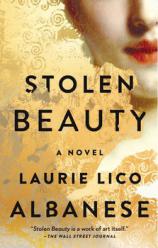Stolen Beauty
Review
Stolen Beauty
A landmark United States Supreme Court decision to return Nazi Germany’s stolen art treasures to their Jewish heirs made headlines across the world in 2005. That decision was based on the proof of rightful ownership of the famous Lady in Gold portrait by Gustav Klimt to the family of Maria Altmann nearly one century after the painting was created. This amazing story gained more attention through a recent movie of the same name, starring Helen Mirren.
The beautiful subject of the painting was Viennese socialite Adele Bloch-Bauer, born in Vienna in 1881. The young wife of wealthy Austrian industrialist Ferdinand Bloch-Bauer, she would become a patron of the arts. The story begins as Adele, a bright, studious young girl with a crippled hand, is encouraged by her brother to go against late-19th-century convention for girls not to be educated. She follows his advice and studies the arts, music and science. Because of her family’s prominent position in Viennese society, she meets many famous artists through the growing popularity of salons spreading throughout Europe. Among them is Gustav Klimt, who asks her to pose for him at his studio.
"STOLEN BEAUTY is about much more than Klimt’s art and his association with Adele.... [It] is a compelling story of our times."
Klimt had a reputation for romancing his models, and this sumptuous novel explores the Secessionist period, its risqué lifestyle and influences on modern art of the era. The sexual themes displayed in his paintings scandalize old-school art critics and lead to the banning of his work from public exhibition. Few family members know that Adele was the subject of two of his most famous paintings, Judith I and Judith II, depicting the biblical Judaic apocryphal heroine who slays Holofernes. The paintings are shown publicly but remain in the family’s private collection, and Maria Altmann, Adele’s favored niece, recalls frequently visiting her Aunt Adele where the paintings were displayed proudly in the Bloch-Bauer mansion.
However, STOLEN BEAUTY is about much more than Klimt’s art and his association with Adele. While his work was frequently denounced for its eroticism, it was later made even more infamous when it was vilified by the growing Nazi movement because of some of his Judaic subjects. When nearly 40 years later the Nazis invade Austria, and Maria and her family members are forced one by one to flee Vienna to Paris, they try to hide the painting. Precious works of art, jewels and entire business enterprises are raided and stolen as the Nazis invade Austria during the War. The Altmanns are only one family among tens of thousands of Jews who lose their entire fortunes, including substantial business holdings. “Aryanizing” enters the lexicon as entire populations and languages vanish beneath the invading forces. Some in Maria’s family are sent to Auschwitz and other camps where they are tortured until their fortune is finally depleted. The surviving Altmanns eventually migrate through Paris to Canada.
More than a century spans the time from the early love affair between Adele and Gustav Klimt to Maria Altmann’s terrifying escape ahead of the invaders. The eventual restoration of these works of art to their rightful heirs follows decades of legal battles to redeem the paintings from the Austrians.
“There are still over 100,000 missing works of art that were looted by the Nazis during the war,” author Laurie Lico Albanese states in the novel’s afterword. STOLEN BEAUTY is a compelling story of our times.
Reviewed by Roz Shea on March 17, 2017
Stolen Beauty
- Publication Date: November 14, 2017
- Genres: Fiction, Historical Fiction
- Paperback: 320 pages
- Publisher: Washington Square Press
- ISBN-10: 1501131990
- ISBN-13: 9781501131998





